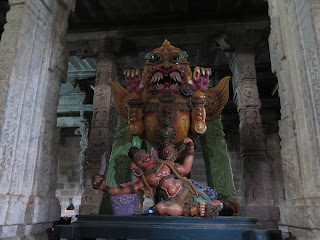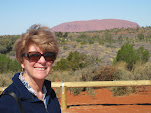Charlie and I had about 10 hours of sleep which made today possible. We had the buffet breakfast and met our guide Vijaya and our driver Balla. We drove to Kanchipuram about 20 km away. That doesn't sound awful, but the road to the town is filled with the usual assortment of odd vehicles that I described yesterday, and, in addition, an amazing number of trucks. The ride took an hour and a half, and I was delighted I wasn't doing the driving. I am amazed that there aren't bodies and crushed vehicles all over the Indian roads. The trucks are painted in a very jolly way. Vijaya explained that several wider trucks (almost the most painted on the road) were water trucks that carried clean water to customers.
Our first stop was the Ekambareshwara Temple. The Pallava leaders built the temple originally as a fortress. The first of the walls was built around 800 years ago. There were several walls outside the original. The carvings from granite were done in the 1500s. The temple is dedicated to Shiva, the destroyer, in his earth manifestation. Since it was Saturday, lots of people had come to pray at the interior shrine. We were allowed to walk and take photos everywhere but in the shrine itself. The most interesting story about Shiva was that Parvati (his consort) snuck up on him when he was meditating and put her hands over his eyes. Since Shiva created the world, universe and everything else, that action caused everything to essentially disappear. Shiva told Parvati to leave. She, according to the legend, created a lingum and sat next to it under a mango tree for a ridiculously long time - several thousand centuries. Shiva was impressed by her loyalty they re-united. Sigh.
Our second stop was at the Kailasanatha Temple, another temple dedicated to Shiva. This temple is older than the first one we saw and the carvings are made from yellow sandstone. Due to the softness of the rock several were not in very good shape. This temple was less crowded than the first and more pleasant to walk around.
Kanchipuram is famous for silk weaving. The people who live here are farmers, but when the season slows they have taken to weaving silk. The silk itself is from Bangalore. It is brought to Kanchipuram where it is dyed and woven into fabric. The silk from here is 6 strands thick and is woven with threads of gold plated silver. Needless to say, the saris made from this stuff are extremely heavy. Beautiful, but very heavy. We saw a couple of weavers and went to a shop with silk goods.
Our third temple visit was to Vaikunta Perumai Temple. This temple was dedicated to Vishnu, the preserver. It was around noon when we went to see the temple. Hindu temples are open in the morning. During that time people "wake the god up", then offer the god some food. Then the god rests (from noon until 4). At 4 the temple reopens until 8. It is open apparently for tea time and another meal. Eventually the god goes to bed, and the temple shuts again.
We had lunch in a small hotel restaurant in Kanchipurma . Very nice meal and a good end to our visit.
We drove back to Chennai, but the traffic was really awful. We originally were going to stop along the beach, but it began to rain and we were a bit spent. So we drove along the beach - the ocean is the Bay of Bengal. The fishermen we had seen from the hotel were selling their wares along the sand/street verge. They lived in tiny wood hovels in the area. Vijaiya told us that when the tsunami came ashore after the Indonesian earthquake, most of the fishermen's huts were washed away.
Back to the hotel, Indian dinner tonight. Very nice. We've eaten in every restaurant in the hotel - strange victory.
Our first stop was the Ekambareshwara Temple. The Pallava leaders built the temple originally as a fortress. The first of the walls was built around 800 years ago. There were several walls outside the original. The carvings from granite were done in the 1500s. The temple is dedicated to Shiva, the destroyer, in his earth manifestation. Since it was Saturday, lots of people had come to pray at the interior shrine. We were allowed to walk and take photos everywhere but in the shrine itself. The most interesting story about Shiva was that Parvati (his consort) snuck up on him when he was meditating and put her hands over his eyes. Since Shiva created the world, universe and everything else, that action caused everything to essentially disappear. Shiva told Parvati to leave. She, according to the legend, created a lingum and sat next to it under a mango tree for a ridiculously long time - several thousand centuries. Shiva was impressed by her loyalty they re-united. Sigh.
Walkway inside the temple
A peek at the inner sanctum in which we were not allowed
One of the carved figures that are carried around with the a carving of Shiva on holidays
A mango tree inside the temple. It's an offshoot of a 3500 year old tree that recently died. Obviously representing the Shiva/Parvati story
Most temples in these parts have a pond of water with a small building in the center like this one,
A view of the from the outside of the tower of the temple
Our second stop was at the Kailasanatha Temple, another temple dedicated to Shiva. This temple is older than the first one we saw and the carvings are made from yellow sandstone. Due to the softness of the rock several were not in very good shape. This temple was less crowded than the first and more pleasant to walk around.
Street scene near the temple
Outside of the Kailasanatha Temple. Vijaiya taking her shoes off - we all had to
A view from inside showing yellow sandstone carvings and the depth of the interior
Charlie the tourist
Judy and Charlie as tourists
Kanchipuram is famous for silk weaving. The people who live here are farmers, but when the season slows they have taken to weaving silk. The silk itself is from Bangalore. It is brought to Kanchipuram where it is dyed and woven into fabric. The silk from here is 6 strands thick and is woven with threads of gold plated silver. Needless to say, the saris made from this stuff are extremely heavy. Beautiful, but very heavy. We saw a couple of weavers and went to a shop with silk goods.
Another street scene in Kanchipuram
A silk weaving loom. Notice the cards on the upper left - they are like computer cards to determine the pattern
On the walk to see a second loom
A woman spinning silk threads together. They are incredibly fine
Her loom
Our third temple visit was to Vaikunta Perumai Temple. This temple was dedicated to Vishnu, the preserver. It was around noon when we went to see the temple. Hindu temples are open in the morning. During that time people "wake the god up", then offer the god some food. Then the god rests (from noon until 4). At 4 the temple reopens until 8. It is open apparently for tea time and another meal. Eventually the god goes to bed, and the temple shuts again.
Street chaos
Inside the third temple
The snakes under the tree are put there by woman who have trouble conceiving. The idea is that the snakes will help.
We had lunch in a small hotel restaurant in Kanchipurma . Very nice meal and a good end to our visit.
We drove back to Chennai, but the traffic was really awful. We originally were going to stop along the beach, but it began to rain and we were a bit spent. So we drove along the beach - the ocean is the Bay of Bengal. The fishermen we had seen from the hotel were selling their wares along the sand/street verge. They lived in tiny wood hovels in the area. Vijaiya told us that when the tsunami came ashore after the Indonesian earthquake, most of the fishermen's huts were washed away.
Back to the hotel, Indian dinner tonight. Very nice. We've eaten in every restaurant in the hotel - strange victory.





























